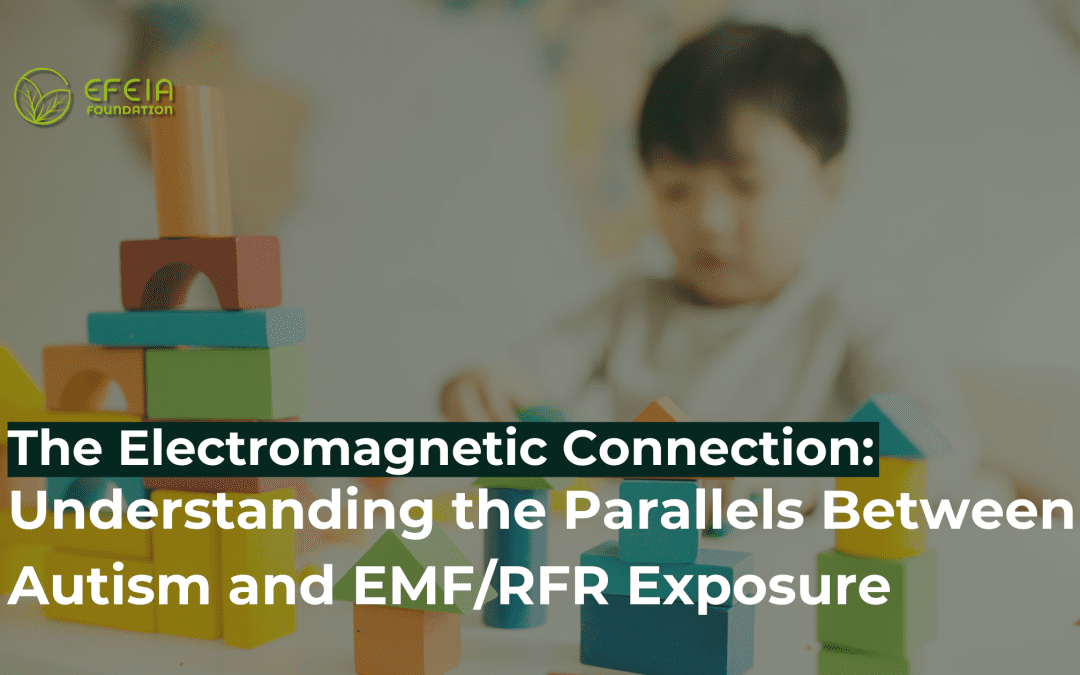When families receive an autism diagnosis, they typically encounter explanations centered on genetics and brain development. Yet for many, questions linger about why autism rates have risen so dramatically in recent decades, and whether environmental factors might play a role in their child’s condition.
These questions drive researchers like Dr. Martha Herbert of Harvard Medical School and Cindy Sage of Sage Associates, who authored a groundbreaking scientific review titled “Findings in Autism (ASD) Consistent with Electromagnetic Fields (EMF) and Radiofrequency Radiation (RFR).” Published as Section 20 of the BioInitiative Report in 2012, their work explores connections many others have overlooked.
As wireless technology becomes increasingly ubiquitous in our daily lives, Herbert and Sage pose an important question: Could our increasingly wireless world be affecting vulnerable developing brains?
Their research doesn’t claim that electromagnetic fields cause autism. Rather, it meticulously documents remarkable parallels between the biological effects of EMF/RFR exposure and the physiological abnormalities seen in autism. These parallels suggest that electromagnetic exposures could potentially contribute to or exacerbate autism by affecting already-vulnerable biological systems.
Perhaps most importantly, Herbert and Sage challenge the traditional view of autism as a fixed, primarily genetic brain disorder. Instead, they propose we understand autism as a dynamic condition involving ongoing physiological challenges that can be influenced by environmental factors, potentially change over time, and possibly respond to interventions that support underlying physiology.
This perspective offers hope: if external factors like EMF/RFR contribute to autism, modifying these exposures might help reduce symptoms and improve quality of life. For families navigating the challenges of autism, such possibilities matter deeply.
Let’s examine the specific physiological parallels Herbert and Sage identified between autism and EMF/RFR effects in their landmark review.
Key Findings: Physiological Parallels Between ASDs and EMF/RFR Effects
1. Oxidative Stress and Cellular Damage
In Autism: When scientists examine blood samples from children with autism, they consistently find signs of oxidative stress—a condition where cells struggle to neutralize harmful free radicals. Many children with autism have reduced levels of antioxidants, particularly glutathione, which serves as the body’s primary defense against oxidative damage. This leaves their cells more vulnerable to injury from various stressors.
EMF/RFR Effects: Herbert and Sage review numerous studies showing that exposure to electromagnetic fields and radiofrequency radiation increases production of reactive oxygen species (ROS)—unstable molecules that damage cells. Even at levels considered “safe” by current standards, EMF/RFR exposure can diminish antioxidant defenses and trigger a cascade of cellular damage. Particularly concerning is research by Lai and Singh demonstrating that EMF exposure can lead to DNA strand breaks, potentially compromising normal cellular function.
The parallel is striking: the same oxidative stress that characterizes autism can be induced by EMF/RFR exposure, suggesting that these exposures might worsen oxidative damage in already-vulnerable individuals.
2. Membrane and Barrier Dysfunction
In Autism: Our bodies depend on various barriers to maintain proper function—from the membranes around individual cells to the specialized barriers protecting the brain and gut. In autism, research shows altered cell membrane composition and increased rates of intestinal permeability, commonly known as “leaky gut.” Many children with autism experience gastrointestinal symptoms consistent with compromised intestinal barriers, while neuroinflammation in autism suggests possible blood-brain barrier dysfunction as well.
EMF/RFR Effects: One of the most compelling findings in EMF research involves barrier disruption. Studies by Salford and colleagues demonstrated that even brief, relatively low-level EMF exposures can increase permeability of the blood-brain barrier, allowing potentially harmful substances to enter brain tissue. EMF/RFR exposure also affects cell membrane function, altering fluidity and disrupting the tight junctions that maintain barrier integrity.
These findings suggest that EMF/RFR exposure could potentially compromise already-vulnerable barrier systems in individuals with autism, worsening systemic effects.
3. Calcium Signaling Disruption
In Autism: Calcium plays a crucial role in brain development and neuronal communication. Some genetic studies in autism have identified alterations in genes associated with calcium channels. When calcium signaling goes awry, it can affect everything from neurotransmitter release to synapse formation—processes implicated in autism.
EMF/RFR Effects: Some of the earliest and most replicated findings in EMF research involve calcium. Herbert and Sage highlight pioneering work by Adey demonstrating that extremely weak electromagnetic fields can trigger calcium efflux from brain tissue—essentially causing calcium to inappropriately flow out of cells. EMF exposure alters calcium-binding proteins and calcium channel function, disrupting this essential signaling system.
This shared calcium disruption pathway provides a potential mechanism through which EMF/RFR might influence neurological function in autism.
4. Mitochondrial Dysfunction
In Autism: Mitochondria—the cellular powerhouses that generate energy—function abnormally in many individuals with autism. Even without classic mitochondrial disease, studies reveal reduced energy production and altered mitochondrial metabolism in autism. When cells can’t produce adequate energy, particularly energy-hungry brain cells may not function optimally.
EMF/RFR Effects: The review presents compelling evidence that EMF/RFR exposure can damage mitochondrial structure and function. Exposure can impair the electron transport chain (the cellular energy production system), reduce ATP (energy) production, and cause mitochondrial DNA damage. Since the brain consumes approximately 20% of the body’s energy while comprising only 2% of its weight, mitochondrial dysfunction particularly affects neurological function.
For individuals with autism who already have compromised mitochondrial function, EMF/RFR exposure might further impair energy production, potentially worsening symptoms.
5. Immune System Dysregulation
In Autism: Immune abnormalities appear frequently in autism research. Post-mortem brain studies reveal neuroinflammation and activated microglia (immune cells in the brain). Many individuals with autism show altered cytokine profiles indicating immune activation, and both individuals with autism and their family members have higher rates of immune-related conditions, including allergies and autoimmune disorders.
EMF/RFR Effects: Herbert and Sage document how EMF/RFR exposure influences immune function in multiple ways. It can trigger mast cell degranulation (release of inflammatory compounds), alter immune cell behavior, and promote production of pro-inflammatory cytokines. Johansson’s research demonstrates immunological changes following EMF exposure, including alterations in cells that coordinate immune responses.
This intersection of immune effects provides another pathway through which EMF/RFR exposure might impact individuals with autism, potentially exacerbating immune dysregulation that already exists.
6. Altered Electrophysiology and Brain Function
In Autism: The brain operates through precisely orchestrated electrical activity. In autism, this electrical symphony often plays out differently. Individuals with autism have higher rates of epilepsy and altered EEG patterns. Many experience sleep disruption and sensory processing abnormalities that may reflect underlying electrophysiological differences.
EMF/RFR Effects: Perhaps unsurprisingly, electromagnetic exposures affect the brain’s electrical activity. Studies show that EMF/RFR can alter brain wave patterns, disrupt sleep architecture, change patterns of neuronal firing, and even increase seizure susceptibility in vulnerable individuals. Research by Borbely and Huber demonstrates EMF effects on sleep electroencephalogram patterns, while Marino’s work shows non-linear changes in brain electrical activity from cell phone radiation.
Given that many individuals with autism already experience altered brain electrophysiology, EMF/RFR exposure might further disrupt these delicate electrical patterns.
7. Genetic and Epigenetic Impacts
In Autism: Recent genetic research in autism has revealed an increase in de novo mutations—changes not present in parental genes. Environmental factors may contribute to these genetic changes, and epigenetic alterations (which affect gene expression without changing DNA sequence) appear increasingly important in autism.
EMF/RFR Effects: The review cites concerning evidence that EMF/RFR exposure can cause DNA damage, interfere with DNA repair mechanisms, and affect gene expression. The REFLEX program documented genotoxic effects of radiofrequency fields at levels below existing safety standards. Some research suggests these effects might extend to reproductive cells, with potential implications for future generations.
This genetic dimension adds another layer to potential EMF/RFR impacts, suggesting these exposures might contribute to the genetic and epigenetic changes observed in some cases of autism.
Implications and Recommendations
Based on these extensive parallels, Herbert and Sage propose several important implications:
1. Need for Expanded Research Focus
The authors advocate for broadening autism research beyond genetics and neural circuits to include environmental contributions, specifically investigating EMF/RFR as a potential contributor. They suggest developing research protocols that capture the non-linear, complex biological effects of these exposures, integrating perspectives from multiple disciplines including cellular biology, immunology, and biophysics.
2. Precautionary Approaches in Public Health
Herbert and Sage recommend adopting prudent avoidance of unnecessary EMF/RFR exposures, especially for pregnant women, infants, and children. They suggest reconsidering the widespread deployment of wireless technologies in settings where children learn and develop, creating “electromagnetically clean” zones in schools, therapeutic settings, and homes where needed, and revising safety standards to account for non-thermal biological effects.
3. Clinical Applications for Individuals with ASDs
The review suggests evaluating EMF/RFR exposure as a potential contributing factor to symptom severity and considering exposure reduction as part of comprehensive treatment approaches. They recommend combining EMF/RFR avoidance with strategies that support antioxidant status, mitochondrial function, and immune regulation, while monitoring individual responses, as sensitivity may vary significantly between persons.
A Call for Broader Investigation
For families affected by autism, Herbert and Sage’s research opens a new doorway of possibility. Their work doesn’t offer simple answers or promise cures, but it does suggest that modifiable environmental factors might influence autism’s course—a profound shift from the often-deterministic genetic narrative many families encounter.
Their evidence warrants serious consideration of EMF/RFR as a potential environmental contributor to autism. By shifting toward a model of autism that encompasses ongoing physiological challenges influenced by environmental factors, Herbert and Sage open new avenues for understanding and addressing this complex condition.
This perspective offers something precious: the possibility that by addressing environmental factors and supporting underlying physiology, we might help children with autism navigate the world more comfortably—even if we can’t completely eliminate their challenges.
As our society becomes increasingly wireless, understanding the potential health impacts of these technologies grows ever more important—not to inspire fear, but to inform choices that protect our most vulnerable members while we continue to benefit from technological advancement.
At EFEIA, we believe the path forward lies not in resisting technology, but in developing it responsibly. We invite researchers, clinicians, and families to explore EMF-aware approaches grounded in science, transparency, and human well-being. The time to expand the conversation—and the research—is now.

